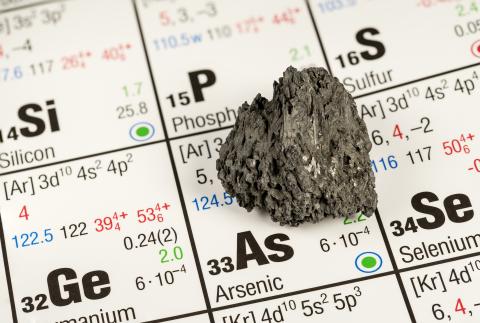Arsenic
What is arsenic?
Arsenic is a naturally occurring mineral that comes in two forms. Inorganic arsenic is found in soil, bedrock, and water. Organic arsenic in naturally found in fish, seafood, and aquatic plants.
Arsenic is used to make metals, glass, electronics, and wood preservatives. In the past, arsenic compounds were predominantly used as pesticides on orchards and cotton fields.
How can I be exposed to arsenic?
People can be exposed to arsenic from air, drinking water, food, and soil.
Air
People can be exposed to arsenic in air from burning, sawing, and sanding arsenic-treated lumber. Additionally, people can be exposed to arsenic in air if they work in places that make or use arsenic such as copper and lead smelters and wood treating facilities.
Drinking water
Arsenic is naturally present in drinking water. High levels of arsenic can also be found in drinking water near sites of environmental contamination or land where arsenic pesticides were used in the past.
Food
Arsenic occurs naturally at low levels in many foods. In most cases, these foods do not pose a health risk. Arsenic is most commonly found in seafood, rice, mushrooms, and poultry.
Soil
People swallow small amounts of soil each day with kids generally swallowing more than adults. Soil naturally contain small levels of arsenic, but can contain higher levels if there are near sites of environmental contamination or land where arsenic pesticides were used in the past.
How can arsenic affect my health?
Exposure to high levels of arsenic can affect everyone. Arsenic is associated with an increased risk of skin, lung, bladder, liver, colon, and kidney cancers. Very high levels of arsenic can affect the skin and nails. Some studies have shown that high levels of arsenic can affect the nervous and circulatory systems.
How can I protect myself and my family from arsenic?
Do not burn arsenic-treated lumber in your home.
If you have or think that have burned arsenic-treated lumber in your home, contact your local health department.
Public water users
Community water systems are required to test for arsenic on a regular basis. If the level of arsenic is above Wisconsin's drinking water standard, your water system will issue a public notice. The public notice will include information on the levels detected, the actions that the system is taking to address the problem, and any steps that you should take to reduce your arsenic exposure.
Private well users
Private well users should test for arsenic routinely using a Wisconsin certified lab.
- Test at least once every five years.
- Test once a year if arsenic was present in previous tests or you live in Outagamie, Winnebago, or Brown county as these areas having naturally higher arsenic levels.
- Households with pregnant people and young children may be eligible for free testing through their local health department.
Take action if the arsenic level is equal to or greater than 10 micrograms per liter (µg/L).
- Retest your well to verify to results.
If the arsenic level is still high:
- Everyone should use a different source of water for drinking and preparing foods that take up a lot of water.
- Options include include bottled water, water from a well without issues, and water from a public system without violations.
- It is ok to use the water for bathing, brushing teething, and washing dishes.
- Find a long-term solution. Options include installing a certified treatment device and drilling a new well.
- Our Water Treatment Devices for Private Well Contaminants fact sheet, P-45012, (PDF) has information on certified treatment devices for arsenic.
- The Wisconsin Department of Natural Resources (DNR) well compensation grants provide funds to address public health hazards in private wells.
Our Arsenic in Private Wells fact sheet, P-45012, has these steps in printable format.
Practicing safe gardening habits can lower exposure to all kinds of soil contaminants, including arsenic. These habits include:
- Wearing gloves when working in the garden.
- Using raised garden beds with clean soil, such as store-bought soil, topsoil, or clean fill from certified sources.
- Adding natural matter like composts and manure to the soil.
- Not eating food, drinking, and smoking when working in the garden.
- Not track dirt from the garden into the house.
- Washing hands after gardening and before eating.
- Washing fruits and vegetables before eating.
- Peeling root crops and removing outer leaves of leafy vegetables before eating.
Who regulates arsenic in Wisconsin?
DNR regulates how much arsenic can be released into the air, surface water (lakes, rivers, and streams), and groundwater in Wisconsin.
DNR also regulates how much arsenic can be in water served by public water systems and oversees the clean up of contaminated sites.
Related topics
Our groundwater standards page has information on how Wisconsin's groundwater standards are set, DHS' role in the process, and a summary of the current and recommended standards including arsenic.
DNR's recommendations for arsenic in drinking water page has information on well casing, well construction, and water treatment for private wells affected by arsenic.
The Wisconsin Groundwater Coordinating Council's Annual Report to the Legislature summarizes the actions that state agencies to address groundwater issues including arsenic.
The University of Wisconsin - Steven Point's Well Water Quality Interactive Viewer shows water quality data from a variety of contaminants (including arsenic) at a county, township, and section levels.
The Agency for Toxic Substances and Disease Registry's ToxFAQs page has more information on arsenic exposure routes and health effects.

